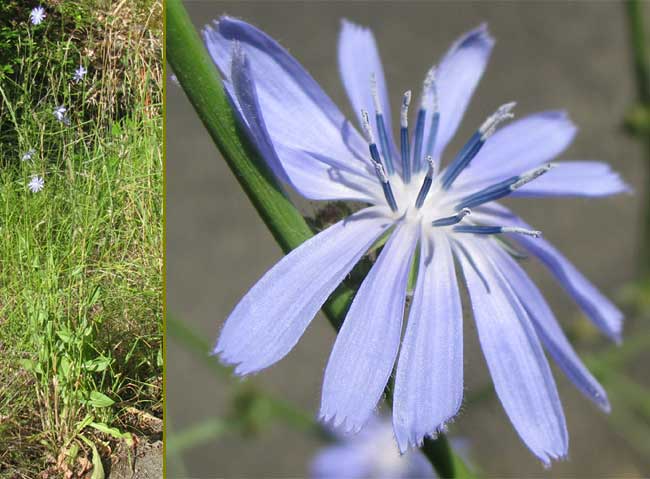Excerpts from Jim Conrad's
Naturalist Newsletter

from the the July 12, 2009 Newsletter, issued from the Siskiyou Mountains west of Grants Pass, Oregon:
CHICORY ALONG ROADS
These days roadsides all across North America are graced with waist-high "weeds" topped with diffuse clusters of blue flower-heads 1-½ inches across. It's a famous plant most people don't recognize, an invasive from Europe. It's Chicory, sometimes called Succory, CICHORIUM INTYBUS, plant and flower head seen above.
Chicory belongs to the Composite or Sunflower Family, so the blue flower-head in the picture is actually a collection of several distinct flowers. The large, flat items radiating from the center are "ray flowers," each tipped with five little teeth, which are the remains of the five petals of ancestral blossoms. The slender, dark blue things arising at the base of each ray flower are cylinders formed by each flower's five pollen-producing anthers grown together along their margins. Fuzzy, pale blue stigmas emerge from the top of the anther-cylinders. The threadlike styles pass inside the cylinders, then the ovary -- the future fruit -- lies hidden deep inside the flower-head's base.
Chicory is famous because its raw leaves taste good in salads, and its substantial taproot can be roasted, ground, brewed, and drunk like coffee, or mixed with it. New Orleans is famous for its coffee blends using chicory root as a flavor enhancer. Back in my Germany days my university friends often served Mischkaffee blended from ground Chicory root, sugar beet and rye. It had a robust, wholesome taste, was much less expensive than coffee, and didn't contain caffeine.
When I lived in Belgium my French-speaking Walloonian neighbors often bought something at local food markets called chicon. It looked like small, white, elongate heads of cabbage and when cooked in milk sauce made a fine dish like cooked cabbage, but much tastier. Chicon heads were produced by forcing chicory roots to sprout indoors without light.
If you dig up a roadside Chicory its taproot will be so small, wiry and gnarly that you won't want to fool with roasting it and grinding it to make New Orleans coffee. And the plant's leaves will be so small and veiny that plain garden-lettuce will seem much to be preferred. However, if you grow the same Chicory in loose, rich garden soil, keep the weeds down and water your plants, you'll start seeing Chicory's potential.
If you really want to grow big roots and/or tasty leaves, however, you should look for garden seeds of the many horticultural varieties. One salad-leaf variety is sold as Radicchio. The variety used to produce chicon sometimes is called Belgian Endive. (Regular garden Endive is another chicory species, Cichorium endivia.)